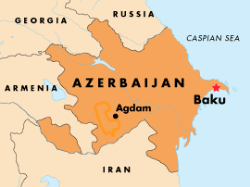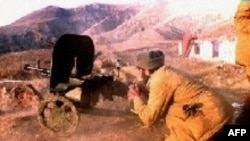Today, 12 years after a ceasefire that froze the fighting but settled nothing, the entire region is paying the social and economic consequences.
But there is a glimmer of hope, as the diplomatic marathon may be bearing fruit. There is talk of a potential deal. In an interview with RFE/RL last week, the U.S. co-chairman of the Organization for Security and Cooperation in Europe's Minsk Group, Stephen Mann, said the peace process was moving in the right direction. The OSCE Minsk Group has been mediating the Karabakh peace talks since 1994.
"All of us recognize that we are at the stage where we have to turn the corner from negotiations to decision. Speaking from the American perspective, we believe that the possibility for a deal exists in the months ahead," Mann said. "So I think the meetings that are coming up are a very important opportunity. We do not want the sides to fail to take advantage of this important opportunity."
Change In Approach
The guarded optimism, it seems, stems from a shift in the Armenian position away from insistence on a package approach to the Karabakh problems, whereby all issues, including the final status of Karabakh, should be solved simultaneously. By all accounts, Yerevan is now prepared to accept a step-by-step approach.
Tom de Waal, an expert on the Caucasus, who is in the Azerbaijani capital, Baku, for the Russian-language launch of his book on the conflict, "Black Garden," thinks this has encouraged Azerbaijan to be more flexible.
"The expectation here is that something will happen in Paris on Friday but that it will probably be just some kind of declaration -- maybe a declaration of basic principles and obviously there are some fairly serious negotiations going on. I think, talking to people in the Foreign Ministry that the tone has changed. They are talking much more constructively, much more in detail about things than they were a couple of years ago," de Waal said.
But how much room does either side have for maneuver? Both sides have encouraged their respective societies to demonize the other. And Azerbaijanis have become accustomed to think that time is on their side, that their booming oil revenues will alter the military balance in their favor.
Paata Zakareishvili, a Georgian specialist on conflict resolution who has just returned from a series of meetings in Armenia and Azerbaijan, thinks that the biggest problem in both countries is the failure of governments to prepare people for compromise.
"People's minds are completely closed. Society is not informed at all. Here [in Georgia], for instance, we're always talking about the federal solution or some other concept or other and this prepares the public for something to happen in Abkhazia. We're always discussing something. But there, there is no discussion whatsoever of concepts, proposals, and plans. All they discuss are Armenia's interests on the one hand and Azerbaijan's on the other," Zakareishvili said.
It's a view shared by de Waal, who fears that the failure of the leaders of both countries to prepare and educate their peoples is storing up problems for the future: "The leaders in private have been having quite detailed confidential discussions about a compromise and society is still stuck in the early 1990s and late 1980s and still stuck with a very aggressive rhetoric towards the other. In that sense, the leaders have become trapped. Even if they make an agreement, it'll be very hard for them to sell it and they'll be quite vulnerable and I think this is where things will get difficult."
For the moment, the flame of hope still flickers in the corridors of the OSCE offices in Vienna. Not so in the refugee camps of Azerbaijan, where it has long since been extinguished. For the hundreds of thousands of people expelled from Karabakh and the adjoining territories by Armenian forces in 1994, life has stood still these last 12 years. Untouched by the oil wealth that has come to Azerbaijan, these refugees still harbor the dream of return to their homes. Perhaps this week in Paris the leaders of both sides will make the first faltering steps to a compromise that might one day make that possible.
The Nagorno-Karabakh Conflict
 Click on the image to view an enlarged map of the Nagorno-Karabakh conflict zone
Click on the image to view an enlarged map of the Nagorno-Karabakh conflict zone
In February 1988, the local assembly in Stepanakert, the local capital of the Azerbaijani region of NAGORNO-KARABAKH, passed a resolution calling for unification of the predominantly ethnic-Armenian region with Armenia. There were reports of violence against local Azeris, followed by attacks against Armenians in the Azerbaijani city of Sumgait. In 1991-92, Azerbaijani forces launched an offensive against separatist forces in Nagorno-Karabakh, but the Armenians counterattacked and by 1993-94 had seized almost all of the region, as well as vast areas around it. About 600,000 Azeris were displaced and as many as 25,000 people were killed before a Russian-brokered cease-fire was imposed in May 1994.
CHRONOLOGY: For an annotated timeline of the fighting around Nagorno-Karabakh in 1988-94 and the long search for a permanent settlement to the conflict, click here.
 Click on the icon to view images of the Nagorno-Karabakh conflict (Flash required)
Click on the icon to view images of the Nagorno-Karabakh conflict (Flash required)
To view an archive of all of RFE/RL's coverage of Nagorno-Karabakh, click here.










